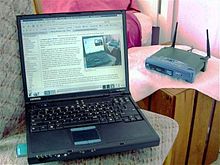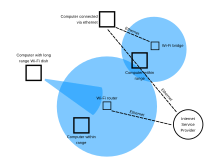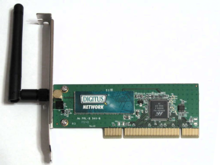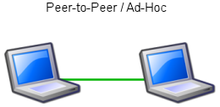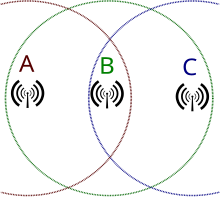
IEEE 802.11 is part of the IEEE 802 set of local area network (LAN) technical standards, and specifies the set of medium access control (MAC) and physical layer (PHY) protocols for implementing wireless local area network (WLAN) computer communication. The standard and amendments provide the basis for wireless network products using the Wi-Fi brand and are the world's most widely used wireless computer networking standards. IEEE 802.11 is used in most home and office networks to allow laptops, printers, smartphones, and other devices to communicate with each other and access the Internet without connecting wires. IEEE 802.11 is also a basis for vehicle-based communication networks with IEEE 802.11p.

A wireless network is a computer network that uses wireless data connections between network nodes. Wireless networking allows homes, telecommunications networks and business installations to avoid the costly process of introducing cables into a building, or as a connection between various equipment locations. Admin telecommunications networks are generally implemented and administered using radio communication. This implementation takes place at the physical level (layer) of the OSI model network structure.

Wi-Fi is a family of wireless network protocols based on the IEEE 802.11 family of standards, which are commonly used for local area networking of devices and Internet access, allowing nearby digital devices to exchange data by radio waves. These are the most widely used computer networks, used globally in home and small office networks to link devices and to provide Internet access with wireless routers and wireless access points in public places such as coffee shops, hotels, libraries, and airports to provide visitors.

In computer networking, a wireless access point, or more generally just access point (AP), is a networking hardware device that allows other Wi-Fi devices to connect to a wired network or wireless network. As a standalone device, the AP may have a wired connection to a switch or router, but, in a wireless router, it can also be an integral component of the router itself. An AP is differentiated from a hotspot, which is a physical location where Wi-Fi access is available.

In IEEE 802.11 wireless local area networking standards, a service set is a group of wireless network devices which share a service set identifier (SSID)—typically the natural language label that users see as a network name. A service set forms a logical network of nodes operating with shared link-layer networking parameters; they form one logical network segment.

The Wi-Fi Alliance is a non-profit organization that owns the Wi-Fi trademark. Manufacturers may use the trademark to brand products certified for Wi-Fi interoperability. It is based in Austin, Texas.
A wireless distribution system (WDS) is a system enabling the wireless interconnection of access points in an IEEE 802.11 network. It allows a wireless network to be expanded using multiple access points without the traditional requirement for a wired backbone to link them. The notable advantage of WDS over other solutions is that it preserves the MAC addresses of client frames across links between access points.
IEEE 802.11r-2008 or fast BSS transition (FT), is an amendment to the IEEE 802.11 standard to permit continuous connectivity aboard wireless devices in motion, with fast and secure client transitions from one Basic Service Set to another performed in a nearly seamless manner. It was published on July 15, 2008. IEEE 802.11r-2008 was rolled up into 802.11-2012. The terms handoff and roaming are often used, although 802.11 transition is not a true handoff/roaming process in the cellular sense, where the process is coordinated by the base station and is generally uninterrupted.

A beacon frame is a type of management frame in IEEE 802.11 WLANs. It contains information about the network. Beacon frames are transmitted periodically; they serve to announce the presence of a wireless LAN and to provide a timing signal to synchronise communications with the devices using the network. In an infrastructurebasic service set (BSS), beacon frames are transmitted by the access point (AP). In ad hoc (IBSS) networks, beacon generation is distributed among the stations. For the 2.4 GHz spectrum, when having more than 15 SSIDs on non-overlapping channels, beacon frames start to consume significant amount of air time and degrade performance even when most of the networks are idle.

Wireless security is the prevention of unauthorized access or damage to computers or data using wireless networks, which include Wi-Fi networks. The term may also refer to the protection of the wireless network itself from adversaries seeking to damage the confidentiality, integrity, or availability of the network. The most common type is Wi-Fi security, which includes Wired Equivalent Privacy (WEP) and Wi-Fi Protected Access (WPA). WEP is an old IEEE 802.11 standard from 1997. It is a notoriously weak security standard: the password it uses can often be cracked in a few minutes with a basic laptop computer and widely available software tools. WEP was superseded in 2003 by WPA, a quick alternative at the time to improve security over WEP. The current standard is WPA2; some hardware cannot support WPA2 without firmware upgrade or replacement. WPA2 uses an encryption device that encrypts the network with a 256-bit key; the longer key length improves security over WEP. Enterprises often enforce security using a certificate-based system to authenticate the connecting device, following the standard 802.11X.
IEEE 802.11u-2011 is an amendment to the IEEE 802.11-2007 standard to add features that improve interworking with external networks.
Mobile VoIP or simply mVoIP is an extension of mobility to a voice over IP network. Two types of communication are generally supported: cordless telephones using DECT or PCS protocols for short range or campus communications where all base stations are linked into the same LAN, and wider area communications using 3G or 4G protocols.

My Life Online (Mylo) was a device created and marketed by Sony for portable instant messaging and other Internet-based communications, browsing Internet web sites using the Opera web browser and playback and sharing of media files. The pocket-sized, tablet-shaped handheld device, which debuted in 2006, had a screen which slid up to reveal a QWERTY keyboard. The brand name 'Mylo' means My Life Online. Using Wi-Fi instead of cellular networks, the Mylo was targeted to the 18–24 age group.
IEEE 802.11b-1999 or 802.11b is an amendment to the IEEE 802.11 wireless networking specification that extends throughout up to 11 Mbit/s using the same 2.4 GHz band. A related amendment was incorporated into the IEEE 802.11-2007 standard.
IEEE 802.11g-2003 or 802.11g is an amendment to the IEEE 802.11 specification that operates in the 2.4 GHz microwave band. The standard has extended link rate to up to 54 Mbit/s using the same 20 MHz bandwidth as 802.11b uses to achieve 11 Mbit/s. This specification, under the marketing name of Wi‑Fi, has been implemented all over the world. The 802.11g protocol is now Clause 19 of the published IEEE 802.11-2007 standard, and Clause 19 of the published IEEE 802.11-2012 standard.
There are several uses of the 2.4 GHz ISM radio band. Interference may occur between devices operating at 2.4 GHz. This article details the different users of the 2.4 GHz band, how they cause interference to other users and how they are prone to interference from other users.
IEEE 802.11ac-2013 or 802.11ac is a wireless networking standard in the IEEE 802.11 set of protocols, providing high-throughput wireless local area networks (WLANs) on the 5 GHz band. The standard has been retroactively labelled as Wi-Fi 5 by Wi-Fi Alliance.
IEEE 802.11s is a wireless local area network (WLAN) standard and an IEEE 802.11 amendment for mesh networking, defining how wireless devices can interconnect to create a wireless LAN mesh network, which may be used for relatively fixed topologies and wireless ad hoc networks. The IEEE 802.11s task group drew upon volunteers from university and industry to provide specifications and possible design solutions for wireless mesh networking. As a standard, the document was iterated and revised many times prior to finalization.
IEEE 802.11ah is a wireless networking protocol published in 2017 called Wi-Fi HaLow as an amendment of the IEEE 802.11-2007 wireless networking standard. It uses 900 MHz license-exempt bands to provide extended-range Wi-Fi networks, compared to conventional Wi-Fi networks operating in the 2.4 GHz, 5 GHz and 6 GHz bands. It also benefits from lower energy consumption, allowing the creation of large groups of stations or sensors that cooperate to share signals, supporting the concept of the Internet of things (IoT). The protocol's low power consumption competes with Bluetooth, LoRa, and Zigbee, and has the added benefit of higher data rates and wider coverage range.
Wi-Fi 6, or IEEE 802.11ax, is an IEEE standard from the Wi-Fi Alliance, for wireless networks (WLANs). It operates in the 2.4 GHz and 5 GHz bands, with an extended version, Wi-Fi 6E, that adds the 6 GHz band. It is an upgrade from Wi-Fi 5 (802.11ac), with improvements for better performance in crowded places. Wi-Fi 6 covers frequencies in license-exempt bands between 1 and 7.125 GHz, including the commonly used 2.4 GHz and 5 GHz, as well as the broader 6 GHz band.

